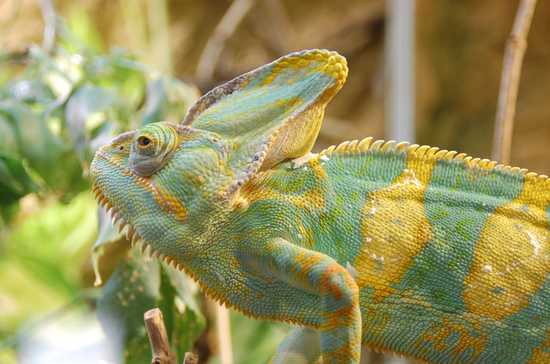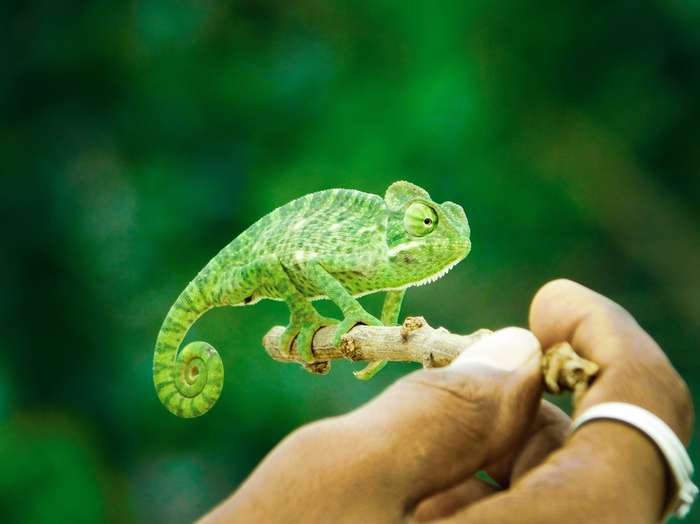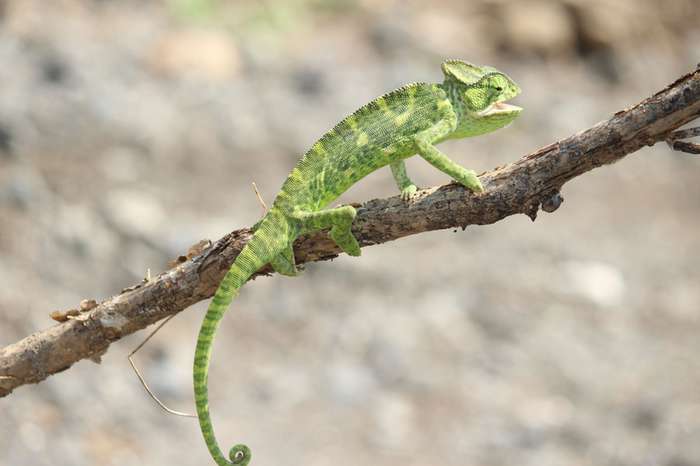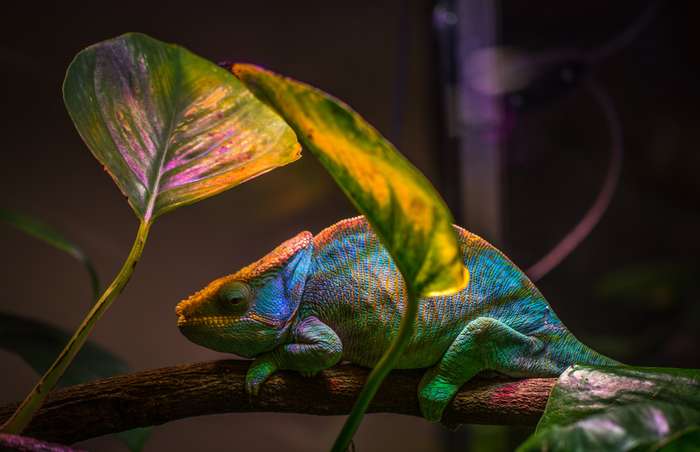If you concerned that your chameleon is dying, the first step is to seek the help of a veterinarian. This article will help you understand the possible causes of a dying chameleon.
Do you own a chameleon?
Is she showing signs of illness, or have you noticed changes in her habits and behavior?
If you answered yes, this article is for you.
Chameleons often mask their illnesses until the condition is serious. Meaning that by the time you notice signs of illness in your chameleon. It may already be dying and need immediate medical attention.
Below we reveal common diseases and symptoms to help you know how to tell if a chameleon is dying.
Common signs that a chameleon is dying. Include sunken eyes, lethargy, sagging skin, weight loss. And unusual colouration, but what causes these symptoms, and what can you do to prevent and treat them?
Common reasons for a dying chameleon:
Chameleons are fascinating animals that can be quite challenging to care for. Especially compared to other lizards such as iguanas or bearded dragons. Chameleons are beautiful, solitary, peaceful animals with unique habitat requirements. To live healthy lives in captivity.
This article will look at the most common causes of chameleon death – dehydration. Lack of food, parasites and chronic stress – and how to identify and prevent them.

Poor or incorrect diet:
Chameleons are omnivorous lizards with varied diets. They combine hunting with plants in the wild to get the necessary nutrients.
Mimicking a captive chameleon’s natural diet can be quite challenging. And not doing it right can put your pet’s health at risk.
If your chameleon is not fed as much as it needs. It can show behavioural changes such as lethargy. Mucus from the mouth and nose, and an almost constant lack of energy.
Dehydration:
Chameleons are extreme delicate animals that need to live in a humid environment. Since the amount of mist they need is difficult to reproduce in an enclosed space. Dehydration is the most common cause of death for chameleons. Dehydration can be fatal if not treated in time. So if you notice unusual behaviour in your pet. Cut possible dehydration to avoid serious health complications.
What to do if your chameleon dehydrated:
Make an appointment with your certified reptile veterinarian to determine. If your misting, humidity level. And water availability are appropriate for your chameleon’s needs.
If so, it could be another disease-causing dehydration.

If your chameleon is five months or older. You can give him a 30-45 minute “shower” by placing a fake or live plant in the chameleon shower. And setting the shower head so that the water hits the wall (not the plant or pet!) and reflects like a fog.
It ensures intensive rehydration of your chameleon.
A terrarium misting system is critical important. And we have a post-reviewing misting system designed for chameleons. That you can check out if you need an upgrade.
Signs of Dehydration in Chameleons:
Dehydration is a condition caused by losing too much fluid from your pet’s body. The body is not getting enough fluids to function proper. Which can manifest in very different ways for your pet.
The most common symptoms of dehydration are sunken eyes. Yellow or orange urates, lethargy, loss of appetite and loss of skin elasticity.
In the early stages of dehydration. Your chameleon may not show all the above symptoms. But early detection of the problem is key to avoiding long-term consequences. Make sure the humidity level in your chameleon’s enclosure matches your animal’s needs. And make an appointment with a reptile vet to assess the problem proper.
If your pet is older than five months, you can also shower it for 30 minutes by placing a live plant in the shower tray. Place the chameleon under the plant and point. The shower head at the wall reflects the water as a mist. Showering will help your dehydrated lizard regain some of the missing water.
Stress:
Chameleons are also very sensitive to stress and will die. If they live under chronic stress for an extended period. Although there are many different types of stress. We can divide them into four large groups: temporary stress as a reaction to a time-bound action. Internal and external physical stress and emotional stress. This categorization responds to the source causing your chameleon to feel anxious. But all the above types can exhibit the same symptoms.
What to do when your chameleon is stress:
Once again, immediately make an appointment with your certified reptile veterinarian. If you think your chameleon is suffering from stress-related health problems.
If possible, it might be best to have your vet visit you at home, as moving around could cause more stress damage.
It is also wise to remove all possible stressors from his environment.
Chameleon stressors include:
1) Poor lighting and heating
2) Mating with another chameleon
3) Too much human treatment
4) See your reflection
5) Changes in its habitat
Signs of Stress in Chameleons:

Greetings from the chameleon:
The chameleon salute involves your pet bringing its leg close to its chest. Sometimes accompanied by a slow backward movement. Usually interpreted by humans as charming. This movement is a sign of fear and anxiety in chameleons.
He inflates his gular:
Inflating the pouch of skin in the neck area to appear larger is a sign of stress in chameleons. Gular usually presents bright colors. And uses this to threaten other chameleons and animals. So even if you’re impressed by your pet’s brighter coloring. It could tell you he’s going through a stressful time.
He was flattening his body:
Chameleons flatten their bodies to appear larger and more ferocious toward potential dangers. But, many other causes do not cause for concern can explain this behavior. Such as the desire to get more sunlight and camouflage.
Yawning:
Keeping the mouth open – is a sign for chameleons that they are about to bite. Chameleons are primary very calm creatures. And unusual aggressiveness and mouthing behavior are signs of that. Your animal is experiencing stress.
Darkening colors:
Chameleons use their color spectrum to express their needs, intentions, and emotional states. A presentation of darkening colors is usually a sign. That your chameleon is afraid or accepting defeat. If your chameleon darkens. When it is in another part of its cage, it is a sign that it is afraid and has decided to assume a submissive role. Closing your eyes is a more extreme symptom of the same anxiety.
Biting:
Although chameleons do not normal exhibit aggressive traits. They can and will bite if stressed. Chameleons have small teeth that can hurt you. And will use them to protect themselves from a stressful situations. A chameleon bite is not dangerous or poisonous, but it is a sign that you should give your pet some space. Biting is normal preceded by other symptoms. Such as hissing, staring, staring, and discoloration
Falling or disking:
If your chameleon jumps when you handle it, it is experiencing a lot of stress. It’s a sign that he doesn’t feel safe or comfortable with you to the point. Where jumping into the unknown seems the most viable option. If your chameleon exhibits this behavior. you should reevaluate its living situation. And give it time to learn to trust you and feel comfortable in its cage.
Run:
It may seem a little obvious initial, but it’s more complicated than it seems. Chameleons are animals whose main defence mechanism is camouflage and camouflage. Escaping is, thus, a very radical choice. Which they may lean towards only because of an extreme tense situation. So while standing still doesn’t mean your lizard is comfortable. Running away is certain a sign that it’s experiencing a lot of distress.
Can chameleons play dead?
Yes. Although not very common, chameleons can play dead if they feel threatened. If your chameleon senses it is facing a dangerous situation. It will curl into a fetal position and wait for the threat to disappear.
Playing dead is commonly found in animals. That are low on the food chain because pretending to be dead makes them less likely to eaten or attacked.
What does a sick chameleon look like?
A sick chameleon can have a very different appearance depending on the disease. Chameleons characterized by their colourful and vibrant appearance. So the loss of elasticity and color of the skin is one of the simplest and most typical signs of a sick chameleon. Other signs that your chameleon may be sick. Include lethargic or over distrustful behavior.
Conclusion:
A sick chameleon might present very different appearances depending on their illness. Chameleons are distinctive for their colourful and vibrant appearance. So a loss of flexibility and color in the skin is one of the easiest and most typical symptoms of ill chameleons. Other signs that your chameleon might be sick. Include lethargy or excessive mistrustful behavior.

